Multimedia Application Design
Multimedia Application Design. Introduction. Electronically stored information, is useful only if it is well managed and easily accessed.
Share Presentation
Embed Code
Link
Download Presentation
- user interface
- prototypes
- work flow management
- uncomplicated design
- high speed network connection
- available storage space

samson + Follow
Download Presentation
Multimedia Application Design
An Image/Link below is provided (as is) to download presentation Download Policy: Content on the Website is provided to you AS IS for your information and personal use and may not be sold / licensed / shared on other websites without getting consent from its author. Content is provided to you AS IS for your information and personal use only. Download presentation by click this link. While downloading, if for some reason you are not able to download a presentation, the publisher may have deleted the file from their server. During download, if you can't get a presentation, the file might be deleted by the publisher.
Presentation Transcript
- Multimedia Application Design
- Introduction • Electronically stored information, is useful only if it is well managed and easily accessed. • Not only it is important to manage storage and access, but to determine the most efficient use of mechanisms for input, manipulation, indexing, and distribution of this electronic multimedia information. • We will see design issues related to distributed applications.
- Multimedia Application Development • The process of creating a multimedia application can be sub divided into three steps: 1. Planning the Application Development 2. Content Acquisition and Storage 3. Content Delivery • Application design contains both user interface design and system design.
- Multimedia Application Development • Once the concept for the application has been finalized, the creator must decide what multimedia data will be used for application. • This multimedia data is commonly termed as content. • Content is generally acquired from a source such as video camera or microphone. • Once content is acquired and stored, the application creator must decide how the data will be delivered to the user.
- Planning the Application Development • Before beginning any task, one must decide what is to be accomplished, and what the end product should be. • A set of specifications is created for most applications. • These specification will serve as a base for the application development. • Each application will have different specifications. • The degree of detail in the specifications will depend on the type of application being created and on the time allotted for its completion.
- Planning the Application Development • Prototypes of final application are also created. • Example: Story boards, Authored prototypes and Visual programming. • Storyboards can be hand drawn or computer generated visual presentations of an application’s user interface and program flow. • An authored prototype will provide a detailed example of a user interface but will only support a limited amount of programming logic. • Next step would be to use a visual programming tool such as Microsoft visual Basic that will include programming. • Prototype help in validating application.
- User Interface Design • Design of user interface is important, it affects user’s satisfaction and understanding of the application. • All interaction with application should be done with simple interface. • Devices such as touch screens are used for inexperienced users because of their uncomplicated design. • Input devices such as mice and keyboards are not used when the application is aimed at inexperienced users. • Using a mouse to double click an icon, in a windows icon mouse pointer ( WIMP ) interface, requires more handiness and skill than simply using one’s finger to push a button on a touch screen.
- System Design • When designing an application creator has to look beyond the user interface. • The creator must consider the underlying technologies which will be used to deliver the media to the user. • Time Vs Space trade off need to be considered : that is available bandwidth to the available storage space. • What to use for higher bandwidth: Ethernet LAN, an analog telephone line, a high speed network connection such as ATM, or a WAN such as the internet. • The storage space may consist of primary, secondary storage. • For storage access time need to be considered.
- System Design • How to provide security when multimedia application is connected to network? • Password protection, encryption etc need to be considered. • Limiting the users who can write data to your storage resources and limiting the users who can view the data on your storage resources are two different problems. • Hardware independence and Scalability need to be consider.
- Introduction • Workflow is an important application area that uses multimedia objects in widely distributed operations. • Workflow involves the automation of a business process in order to support and complement the transition of information and tasks between organizational actors. • Workflow becomes important in those sectors or industries that have to deal with vast amounts of information and, in particular, where timely receipt of information is of the essence • Workflow is broadly defined as the automation of work among users where the system is intelligent enough to act based on the definition of document or work type and users, and the re cognition of dynamic processing conditions. • Workflow allows business process management in a predetermined organized manner and allows the flow of information from a desktop or a system to another desktop or a system.
- Work Flow • For example, an insurance claim received by e-mail is routed automatically to a claims investigator. • At that time, a picture or a video of the accident scene is linked using OLE to create a case. • The case is then coded and routed to an adjuster if there is no injury. • If there is an injury, the case is routed to a health inspector. • The health inspector then checks the complete medical record for the person involved in the accident. • The case is then coded accordingly by the health inspector and the case is routed to the adjuster. • The adjuster’s role is to examine the code and apply financial rewards to the case.
- Benefits of Work Flow Management • Processing hundreds of daily letters and inquires that took several weeks can be addressed in a matter of hours. • Keeping track of the status of the customer’s inquiry, which was a lengthy manual process, can become fully automated. • Scanning applications, invoices, contracts, and claims provides rapid access to information. • For example, in a typical work flow based system where customers automatically receive a response in 24 hours.
- Benefits of Work Flow Management • Processing hundreds of daily letters and inquires that took several weeks can be addressed in a matter of hours. • Keeping track of the status of the customer’s inquiry, which was a lengthy manual process, can become fully automated. • Scanning applications, invoices, contracts, and claims provides rapid access to information. • For example, in a typical work flow based system where customers automatically receive a response in 24 hours.
- Elements of Workflow System • The information contained in document. • Forms or files • A set of tasks to be performed on this information • People assigned to perform those tasks. • Set of rules that define how the work is to be processed. • workflow automation refers to the use of information technology to govern the routing of data to and from the people performing workflow tasks.
- Types of Workflow • Production workflow or Transaction based workflow: • It has to handle large volumes of transactions. • It has set rules, and tracks work in progress, and can generate report of the work in progress. • The inputs are well defined and outcomes are generated as a result of inputs. An example of this type of workflow is insurance claim processing.
- Types of Workflow • Mail enabled or Adhoc workflow: • It is low volume and has few rules. • The rules are deigned by users. • For example, a message received from a patient may be routed to different doctors uses mail as the infrastructure to route the information from one desktop to another desktop. • This type of workflow does not track work in progress. • The message will be processed as the individual processes the message.
- Types of Workflow • Document Based Workflow: • This consist of document management in an organized manner. • For example, a draft person creates a drawing which then gets routed to a checker for the checking process. • Document workflow has rules, and information flow. • In this type of workflow the document belong to an owner.
- Types of Workflow • Knowledge Based Workflow: • This is like self learning and builds intelligence as it gets more work done. Like AI. • Object Oriented Workflow: • The workflow objects have properties and methods. • The properties of an object define the attributes of a process. • The methods define processes. • The inheritance of an object allows super or subsets of workflow objects.
- Sequence of events in Workflow system • Capture of Multimedia information, including text, database records, image, voice, audio and video. • Organizing this information into proper order designed for specific application. • Retrieval of multimedia objects for manipulation under application control as well as for display. • Redistribution of multimedia objects to support the sequence of steps in a business process. • Short term as well as long term storage of information. • Output of results consisting of multimedia objects.
- Components of Multimedia Systems • Multimedia Input Systems: • It consist of image scanning as the primary means of non textual input. • It also includes user workstations. • The input node can be listed as follows: • Scanning Node: It consist of a computer to which one or more scanners are connected. The scanning node typically compressed the scanned input for storage. • User Workstation: The user workstation can serve as input node for voice or audio input. It must have high performance CPU, high resolution display, enough storage to cache video input, camera equipment and video capture hardware and software, sound digitizing hardware and software and compression hardware and software.
- Components of Multimedia Systems • Video Capture node: A separate node similar to a user workstation may be used for capturing video.
- Components of Multimedia Systems • Multimedia Output System: Output systems are basically display systems. User Machine : It can be used to serve basic requirement like display of text, image and video. Server Systems: Can have several dedicated servers like: 1. Print server: It will continuously publish the availability of print server and facility for printing the document centrally. One negative aspect: Privacy of confidential document. 2. Fax Server:Facility for sending Fax centrally.
- Components of Multimedia Systems • File Server: Facility for storing and retrieving documents centrally. • Gateway Server: System that provide communication to other node in different network. • Teleconferencing Studio: It will provide facility for teleconferencing with multiple monitors and adequate sound system.
- Components of Multimedia Systems • Multimedia Storage Systems: Storage is one of the major and ever growing requirement of multimedia system. Server Systems : Following are the different mass storage servers which fulfills demand of storage. 1. Database Server: A database server is a computer program that provides database services to other computer programs or computers, as defined by the client server model.
- Components of Multimedia Systems • Image Server: It’s a document management system. It provides easy access to documents. • Audio and Video Server: Video Server: A video server is a computer dedicated to delivering video online, delivering course material in video format, deliver music videos. Audio Server: Manages digitized voice and audio objects.
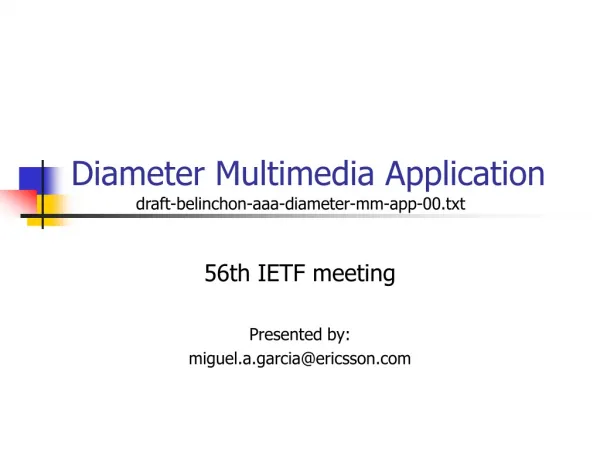
Diameter Multimedia Application
Diameter Multimedia Application. draft-belinchon-aaa-diameter-mm-app-00.txt. 56th IETF meeting Presented by: miguel.a.garcia@ericsson.com. What is it? . A Diameter application taylored for the 3GPP IP Multimedia Subsystem Provides SIP servers with: Authentication Authorization
183 views • 4 slides

Interactive Multimedia Design
2. How Should We Design User Interfaces for Multimedia?. What do we mean by design in this context?. 3. A definition of design: a creative process that draws upon elements, experience, and knowledge from many different sources" (pp. 388, Tannenbaum text)What design process should we use?What
528 views • 51 slides
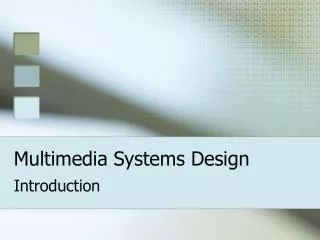 Multimedia Systems Design" width="320px" />
Multimedia Systems Design" width="320px" />
Multimedia Systems Design. Introduction. Introduction. “A Picture is worth a thousand words” There have been ongoing attempts to improve productivity of knowledge workers.
604 views • 49 slides
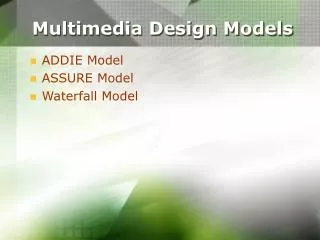
Multimedia Design Models
Multimedia Design Models. ADDIE Model ASSURE Model Waterfall Model. ADDIE Model. Analysis Problem definition Design Design, structure, media types, technological issues Development Based on budget, develop the project Implementation Testing phase Evaluation
289 views • 5 slides
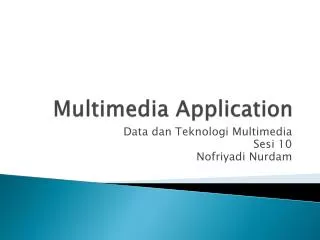
Multimedia Application
Multimedia Application. Data dan Teknologi Multimedia Sesi 10 Nofriyadi Nurdam. Learning Outcomes. At the end of this session, the students will be able to: Compare the categories of multimedia application. Course Outlines. Kiosk CD Interactive CBT. Information Kiosk.
553 views • 36 slides
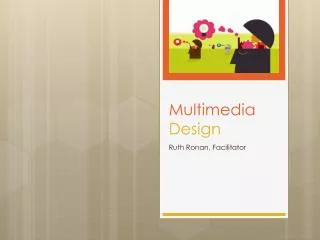
Multimedia Design
Multimedia Design. Ruth Ronan, Facilitator. Objective. Participants will apply the theory of multimedia learning to design a 5-7 slide mini-lecture video presentation for use in an LMS environment. Cognitivism.
303 views • 14 slides
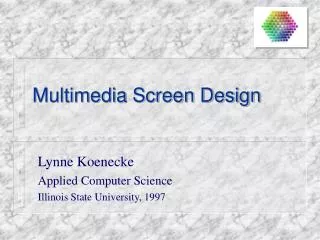
Multimedia Screen Design
Multimedia Screen Design. Lynne Koenecke Applied Computer Science Illinois State University, 1997. Text. place the title for a screen on the top line with at least one blank line before the body of the text use left justification organize complex information into tables
516 views • 36 slides
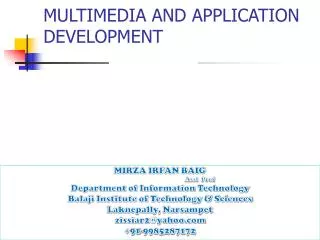
MULTIMEDIA AND APPLICATION DEVELOPMENT
MULTIMEDIA AND APPLICATION DEVELOPMENT. MIRZA IRFAN BAIG Asst Prof Department of Information Technology Balaji Institute of Technology & Sciences Laknepally, Narsampet zissiar2@yahoo.com +91-9985287172. So far…. Color spaces image representations Bitmap grayscale.
612 views • 36 slides

Multimedia Design
Multimedia Design. Objectives. By completion of this session, you will be able to: Organize your multimedia project Develop Flowcharts and Storyboards that represent the product Specify Screen Designs Be equipped with basic Design Guidelines for
461 views • 27 slides

Multimedia Design
Multimedia Design. The Elements and Principles of Design. Look carefully at the following screenshots from professional Multimedia titles. Who Wants To Be A Millionaire- by Disney. #1. Myst by Broderbund. #2. Toy Story by Disney and Pixar. #3. Star Wars Droids by Lucas Arts. #4.
748 views • 60 slides

Multimedia Design
Multimedia Design. Introduction. Contact Details. Dr Judy Robertson Judy.Robertson@hw.ac.uk 0131 451 8223 Rm EM G29 Second Life name: Jxr Greenwood. Overview. Definition of multimedia and active research areas Structure of module – what you’ll learn Assignment information.
424 views • 29 slides

Multimedia Presentation Design
Multimedia Presentation Design. Anders Petersen petersea@uci.edu Ariffin Yahaya ariffin@ics.uci.edu. Papers Presented Today. Automating the Generation of Coordinated Multimedia Explanations (S. K. Feiner and K. R.McKeown)
603 views • 43 slides

Multimedia Design Principles
Multimedia Design Principles. Multiple Representation Principle:. It’s better to present an explanation in words and pictures than solely in words. E.g. use 2 modes of representation rather than 1. (Visual & Verbal) Examples?. Contiguity Principle.
408 views • 6 slides
 Multimedia Systems Design" width="320px" />
Multimedia Systems Design" width="320px" />
Multimedia Systems Design. Contents. Introduction Multimedia elements Multimedia applications Multimedia systems architecture. Introduction. Definitions and terminologies. Multimedia: It is an ideal language for communication
1.67k views • 26 slides

Multimedia Instructional Design
Multimedia Instructional Design. Part II. Why the team creates the CDS. To capture innovative and creative design ideas early in the process. To obtain consensus and shared understanding of the design specifications. To create an appreciation for the necessity for a consistent approach.
314 views • 23 slides

Multimedia design agency
. Multimedia is famous from mixed media in fine art; by including audio, for example, it has a large scope. The term "rich media" is synonymous for interactive multimedia. Hypermedia scales up the amount of media content in multimedia application.
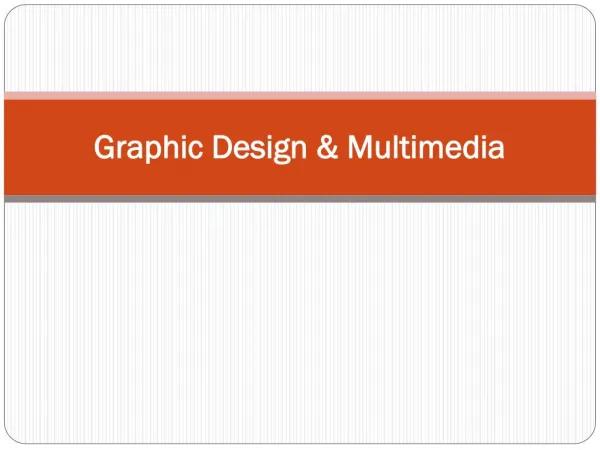
Graphic Design & Multimedia
Multimedia And Graphic Design Course train you in understanding how images, symbols, words, and letters together can be used as an effective means of communication and portray the appropriate message.
205 views • 15 slides

Diameter Multimedia Application
Diameter Multimedia Application. Diameter Multimedia Application draft-johansson-aaa-diameter-mm-app-02.txt Maria-Carmen Belinchon maria.c.belinchon@ericsson.com Miguel-Angel Pallares Carolina Canales Peter J. McCann Jaakko Rajaniemi.

Multimedia Design
Multimedia Design. Table of Content. Multimedia Development Process Navigational structures Storyboard Multimedia interface components Tips for interface design. Multimedia Development Process. Take a long time to be produced. Include four stages: Planning and costing
871 views • 41 slides

Design for Multimedia
Design for Multimedia. Martin Rieser Bath Spa University College. What is Interaction Design?
828 views • 77 slides

Multimedia Design
Multimedia Design. Table of Content. Navigational structures Storyboard Multimedia interface components Tips for interface design. When you are done with the planning stage, it is time for you to organize your content.
451 views • 36 slides





 Multimedia Systems Design" width="320px" />
Multimedia Systems Design" width="320px" />









 Multimedia Systems Design" width="320px" />
Multimedia Systems Design" width="320px" />





